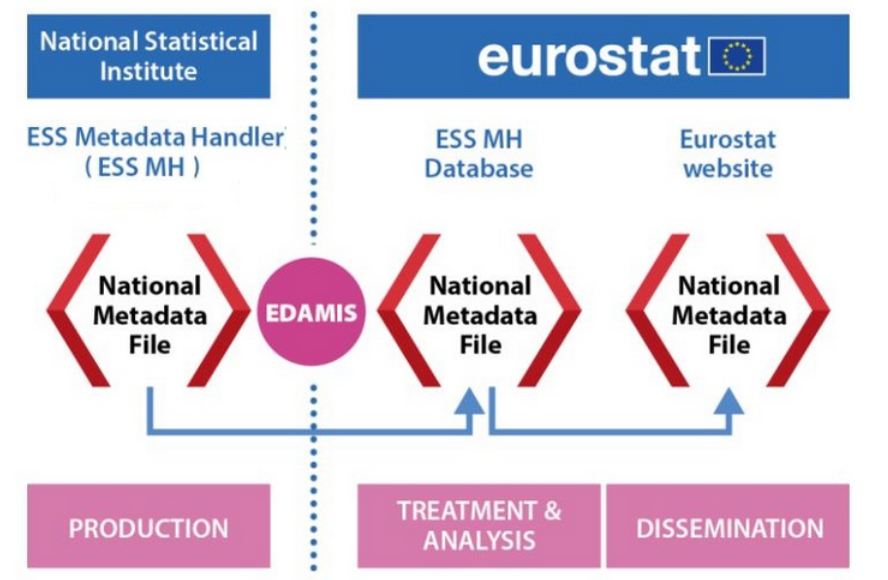ESS Metadata Handler (ESS-MH)
The ESS-MH tool enables the collection, validation, and dissemination of national and European reports according to the metadata standards of the European Statistical System (ESS).

Login requirements, including how to activate the 2 Factor Authentication feature are described in this FAQ.
Contact & Help
For queries on metadata, including issues accessing the ESS-MH, bugs observed and any other support requests, please send an email to ESTAT-DATA-METADATA-SERVICES@ec.europa.eu
Maintenance Calendar
User guides
The ESS-MH user guide offers a comprehensive description of the main ESSMH features
The short ESS-MH user guide lists functionalities accessible to national implementers
The Modelling and interoperability guidelines provides an insight into metadata modelling and interoperability
The Technical specifications for file export and import to ESS Metadata Handler describes all the technical aspects for importing and/or exporting metadata reports
Frequently Asked Questions (FAQs)
Find out answer to the most frequently asked questions about the ESS-MH.
Training opportunities
A number of training courses are available to support national and European implementers meet their metadata obligations. Training activities are regularly organised throughout the year:
- Learn more about the ESS-MH course
- Check out the training calendar and register for the next session
In a nutshell
Reference metadata describe the contents and the quality of the statistical data. That is, they assist users with the interpretation of the data by providing information on statistical concepts and methodologies used for the collection as well as on data quality.
Eurostat is committed to providing reference metadata information for all European statistics. This follows the principle that no data should be collected without metadata. The Metadata Team, in cooperation with production units, ensures that:
- All datasets in the navigation tree are covered by European metadata;
- Whenever possible, national metadata are also disseminated. The availability of national reports, complementing a European report increases transparency, availability and comparability of information.
Standards for reference metadata
The Single Integrated Metadata Structure (SIMS) is a dynamic inventory and conceptual framework for all ESS quality and reference metadata concepts. It is also used as a reporting structure, for European and national metadata. The ESSC has endorsed the Single Integrated Metadata Structure (SIMS) standard in order to comply with the reporting obligations outlined in Article 12 of regulation 223/2009.
The Euro SDMX Metadata Structure (ESMS) contains all the concepts and sub-concepts that are required by a user to understand the data. This fully SDMX compliant reporting structure is widely used across statistical domains for the reporting of European and national metadata.
The Euro SDMX Metadata Structure – Indicator Profile (ESMS-IP) is based on the Euro SDMX Metadata Structure (ESMS). In addition, it comprises a short ‘quality box’ at the top providing users with a summary assessment of the main quality characteristics of an indicator. It is used for datasets which are part of an established indicator set such as SDGs and Europe 2020.
The ESS Standard Quality Report Structure (ESQRS) is a standard for the production and dissemination of quality reports within the ESS. ESQRS files provide users with detailed information for assessing the quality of the data sets released by Eurostat. This metadata structure is mainly used for national quality reports.
Processing European and national reference metadata
The ESS Metadata Handler (ESS MH) is the web application developed by Eurostat for supporting the production, management, exchange and dissemination of European and national reference metadata files based on the above-mentioned standards. The ESS MH is in production since 2014.
The diagram below presents the high level business process for reporting SDMX compliant reference metadata and the usage of the ESS Metadata handler. European and national reports are compiled by Eurostat and national competent authorities, respectively. Production units and Eurostat’s metadata team will validate the content and structure of European and national reports before they are disseminated on Eurostat’s Reference Database (Eurobase).

(Edamis is the single entry point for all data and metadata entering Eurostat)
Other resources
- For testing purposes, you may be asked to use the ESS-MH Acceptance environment. Access to the ESS-MH Acceptance environment can be obtained using the same procedure as in Production, with the difference that users should register and request rights in EDAMIS Acceptance rather than Production
- An overarching presentation of the ESS reference metadata and quality reporting standards can be found on the Eurostat metadata dedicated section
- Guidelines on how to provide information according to the standards are available in the European Statistical System (ESS) handbook for quality and metadata reports
- A list of ongoing metadata implementation projects can be consulted
- A metadata glossary comprising the most common user types, tools and concepts used in Eurostat metadata implementation
